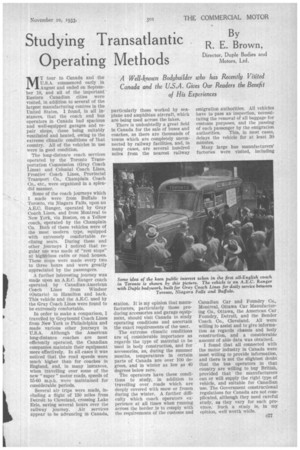Studying Transatlantic Operating Methods
Page 57

If you've noticed an error in this article please click here to report it so we can fix it.
A Well-known Bodybuilder who has Recently Visited Canada and the U.S.A. Gives Our Readers the Benefit of His Experiences
By R. E. Brown,
Director, Duple Bodies and Motors, Ltd.
MY tour to Canada and the U.S.A. commenced early in August and ended on September 18, and all of the important Eastern Canadian cities were visited, in addition to several of the largest manufacturing centres in the United States. I found, in all instances, that the coach and bus operators in Canada had spacious and well-equipped garages and repair shops, these being suitably ventilated and heated, owing to the extreme climatic conditions of That country. All of the vehicles in use were in good condition.
The long-distance coach services operated by the Toronto Transportation Commission (Gray Coach Lines) and Colonial Coach Lines, Frontier Coach Lines, Provincial Transport Co., Champlain Coach Co., etc., were organized in a splendid manner.
Some of the coach journeys which I made were from Buffalo to Toronto, via Niagara Falls, upon an A.E.C. 'Ranger, operated by Gray Coach Lines, and from Montreal to New York, via Boston, on a Yellow coach, operated by the Champlain Co. Both of these vehicles were of the most modern type, equipped with extremely comfortable reclining seats. During these and other journeys 1 noticed that regular use was made of "rest stops" at highlirlass cid& or road houses. These stops were made every two to three hours and were greatly appreciated by the passengers.
A further interesting journey was made upon an A.E.C. Ranger coach operated by Canadian-American Coach Lines from Windsor (Ontario) to Hamilton and back. This vehicle and the A.H.C. used by the Gray Coach Lines were found to be extremely comfortable.
In order to make a comparison, I travelled by Greyhound Coach Lines from New York to Philadelphia and made various other journeys in U.S.A. Although the American long-distance coaches are most efficiently operated, the Canadian companies, maintain their equipment more effectively. In all cases it was noticed that the road speeds were much higher than for coaches in England, and, in many instances, when travelling over some of the new " super " motor roads, speeds of 55-60 m.p.h, were maintained for considerable periods.
Several air trips were made, including a Right of 130 miles from Detroit to Cleveland, crossing Lake Erie, saving several hours over the railway journey. Air services appear to be advancing in Canada, particularly those worked by seaplane and amphibian aircraft, which are being used across the lakes.
There is undoubtedly a great field In Canada for the sale of buses and coaches, as there are thousands of towns which are completely unconnected by railway facilities, and, in many cases, are several hundred miles from the nearest railway station. It is my opinion that manufacturers, particularly those producing accessories and garage equipment, should visit Canada to study operating conditions and ascertain the exact requirements of the user.
The extreme climatic conditions are o4 considerable importance as regards the type of material to be used in body construction, and for accessories, as, during the summer months, temperatures in certain parts of Canada are over 100 degrees, and in winter as low as 40 degrees below zero.
The operators have these conditions to study, in addition to travelling over roads which are deeply covered with snow or frozen during the winter. A further difficulty which coach operators experience at all times when running across the border is to comply with the requirements of the customs and
emigration authorities. All vehicles have to pass an inspection, necessitating the removal of all baggage for customs purposes, and the passing of each passenger by the emigration authorities. This, in most cases, delays the vehicle for at least 30 minutes.
Many large bus manufacturers' factories were visited, including Canadian Car and Foundry Co., Montreal, Ottawa Car Manufacturing Co., Ottawa, the American Car Foundry, Detroit, and the Bender Coach Co., Cleveland. All were willing to assist and to give information as regards chassis and body construction, and a considerable amount of able data was obtained.
I found that all connected with the motor industry in Canada were most willing to provide information, and there is not the slightest doubt that the bus operators in that country are willing to buy British, provided that the manufacturers can or will supply the right type of vehicle, and suitable for Canadian use. The Government constructional regulations for Canada are not complicated, although they need careful study, as they vary for each province. Such a study is, in my opinion, well worth while.




























































































































